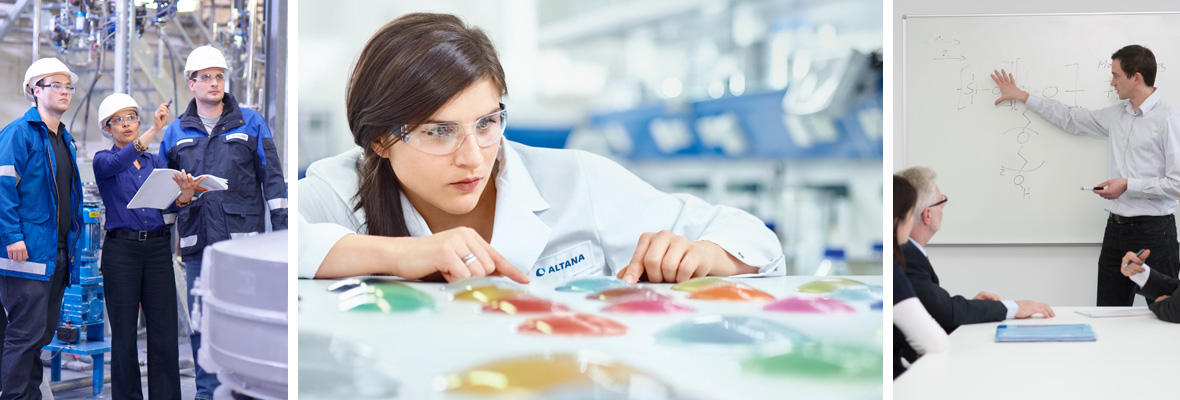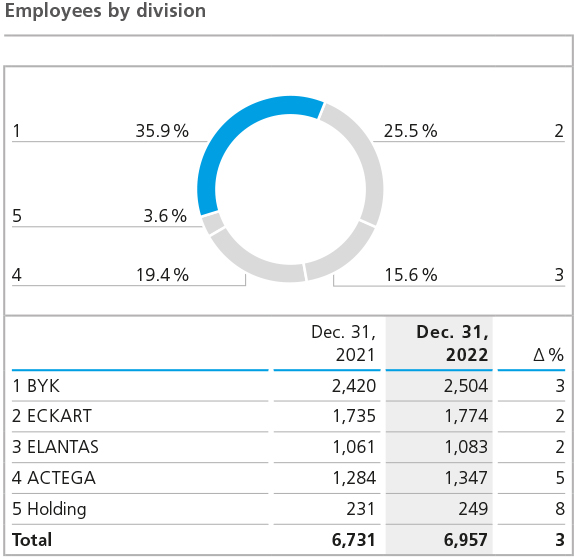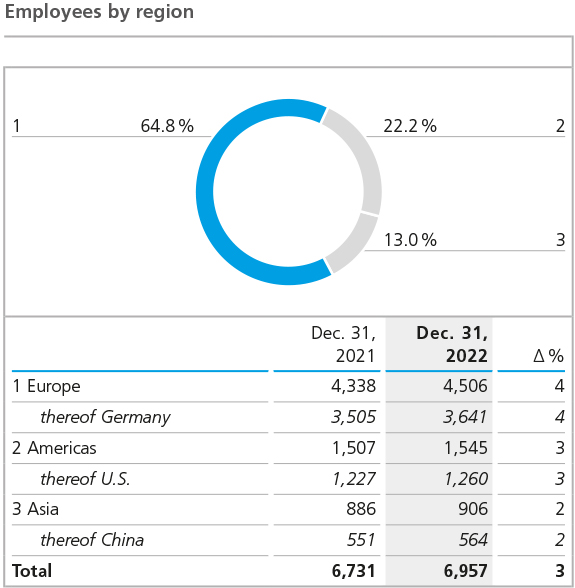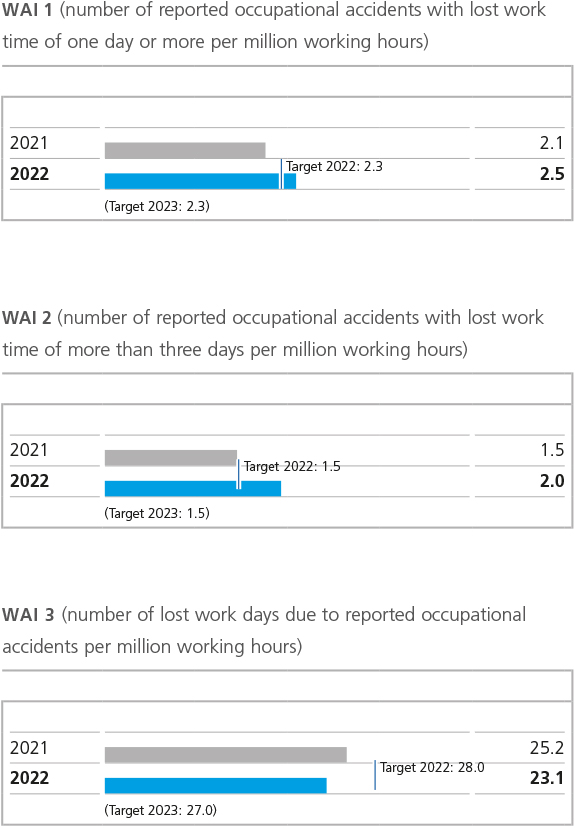Letter from the Management Board | About This Report | Sustainability Management | Corporate Bodies and Management | Report of the Supervisory Board | Shaping the Future Together | Group Management Report | Products | Safety and Health | Environment | People | Social Commitment | Consolidated Financial Statements (condensed version) | Multi-Year Overview | Global Compact: Communication on Progress (COP) | ALTANA worldwide | List of Shareholdings | Overview | Contact
Innovation
As a specialty chemicals company, innovations are an important factor for ALTANA, enabling us to offer our customers new, competitive solutions and at the same time to meet current requirements regarding performance profile, costs, environmental protection, and sustainability. Thanks to close cooperation with our customers, we are able to identify global technology trends at an early stage and to be immediately involved in new development fields. This enables us to develop tailored solutions quickly and reliably. We build on existing competencies, on the one hand, and gain access to new ones on the other, in order to continuously adapt our product portfolio to market and customer needs. There is also great potential to combine our competencies across the divisions to establish innovative solutions on the market more quickly and efficiently. To this end, our researchers and developers have access to the latest analytical methods in our chemical laboratories and application-technology test laboratories. Numerous awards from our customers underscore our success as an innovative solutions provider.
In addition to the activities in the business divisions, selected innovations are initiated and coordinated at the ALTANA level, aimed at tapping new business fields and absorbing technology and market trends. The basis for these innovations are the strong competencies of the divisions along the entire value chain as well as the synergies that arise between the divisions. For the design of new innovation areas, we use three different but thematically complementary approaches: the ALTANA Institute, our technology platforms, and corporate venturing.
With the help of the ALTANA Institute, external networks and close cooperation with universities and research institutes around the world are used to harness outside impetus. Here, we cooperate in the area of basic research on topics that form the foundation of further more application-oriented internal research and development activities. In addition to the technology transfers of the first completed projects to the divisions, this year also saw the establishment of a new international research cooperative venture with the University of Northumbria in Great Britain.
In 2022, ALTANA’s investments in technology platforms were at the previous year’s level. This demonstrates the constant expansion of the area based on targeted cooperation with customers.
The “Printed Electronics” innovation platform that was integrated into the ELANTAS division was able to further increase sales by means of additional new business and to fill the project pipeline further. To further expand its innovative strength in the field of printed electronics, ALTANA acquired a stake in the technology startup Saralon GmbH in December 2022.
As part of the “Cubic Ink” technology platform, we supplemented the versatile product portfolio with special solutions and presented it to the market for the first time at our booth at Formnext, the leading international additive manufacturing technologies trade fair. Due to the sale of shares in the printer manufacturer dp polar in 2022, we were able to present the broad Cubic Ink portfolio for the first time as an independent supplier and as a printer-independent solution, thus accelerating the commercialization of the products.
The laser transfer technology platform HELIOSONIC also made progress. It expanded its pigment portfolio and was thus able to enter into more strategic development partnerships beyond the graphic arts industry. In the field of printed electronics, medical technology, and marking, feasibility studies were completed and the first industrial projects started. In addition, the construction of another printing press began, which will enable a significantly larger printing width than the existing model.
Thanks to the close cooperation between the central departments Corporate Innovation and Corporate Venturing, ALTANA can continuously examine technology and market potential and enter new attractive markets by means of targeted investments in innovative technology companies. In this context, ALTANA again expanded its cooperation with the companies TAU ACT GmbH, Berlin, and the Israeli startup Velox Ltd. in the 2022 fiscal year. At Velox Ltd., following the successful placement of Beta machines with selected customers, there was a positive incoming order development in 2022.
The basis for our innovative strength is an open and dynamic corporate culture that gives the 1,242 employees in our worldwide research and development centers freedom for creative and entrepreneurial action. The equipment in our development centers enables our employees to turn their ideas into market-ready solutions. Our research and development expenses increased by € 13.3 million compared with the previous year (€ 179.7 million) to € 192.9 million. The decrease in the share of sales accounted for by research and development expenses to 6.4 % (previous year: 6.7 %) is solely attributable to the high increase in sales due to inflation. In general, our expenditures are related to the achievement of important milestones, the implementation of individual customer requirements in future innovative products, and the long-term orientation of our innovation activities.
At the end of 2022, the companies of the ALTANA Group employed 6,957 people worldwide (previous year: 6,731). The increase of 226 persons or 3 % compared to the previous year promotes ALTANA’s long-term growth.
In the BYK division, the number of employees rose by 84 to 2,504 (previous year: 2,420). The strongest increase was recorded in the areas of production and supply chain, particularly at the company in Germany.
In the ECKART division, staff numbers increased by 39 to 1,774 in the course of 2022 (previous year: 1,735). The changes mainly concerned production at the site in Hartenstein.
ELANTAS’s workforce grew by 22 persons to 1,083 (previous year: 1,061). The increase in employees was spread across all functional areas.
In the ACTEGA division, staff numbers rose by 63 to 1,347 in the course of the year (previous year: 1,284). The increase was primarily in production, mainly at the division’s North American and German sites.
In the Group’s holding companies, the headcount rose by 18 to 249 in the past fiscal year (prior year: 231). The largest increase was recorded at ALTANA Management Services GmbH, with 11 additional employees.
The functional structure of the workforce did not change significantly in the 2022 fiscal year. With 51 % or 3,568 people (previous year: 3,463), most of the employees continued to work in production. The research and development workforce increased by 21 to 1,242 in 2022 (previous year: 1,221). In marketing and sales, the number of employees increased by a total of 54 to 1,166 in 2022 (previous year: 1,112). In the year under review, 981 people were employed in administration (previous year: 935).
There were also only minor shifts in the regional structure in 2022 compared to the previous year. With 4,506 employees (previous year: 4,338), the European Group companies continued to account for by far the largest share of staff. At the end of the year, 3,641 people (previous year: 3,505) were employed in Germany, the majority at the largest manufacturing and development sites of the ECKART and BYK divisions in Hartenstein and Wesel, respectively. The workforce in the Americas rose by 38 to 1,545 at the end of 2022 (previous year: 1,507). The increase was primarily in North American companies. The number of people employed by Asian Group companies grew from 886 in the previous year to 906 in 2022, with the largest increase in China.
At the end of the 2022 fiscal year, 1,825 women and 5,132 men worked for ALTANA. 89 % of all employees had an unlimited and 11 % a limited employment contract on the balance sheet date. This ratio was virtually the same for both genders. 74 % of the female employees worked fulltime and 26 % part-time at the end of 2022. Among male employees, 98 % worked full-time. Apart from its own employees,128 people from employment agencies worked for the ALTANA Group on December 31, 2022.
The colleagues in the ALTANA Group are the key to our sustainable success and an integral part of ALTANA’s culture. There is now international competition for specialists and managers in all of our employee markets. As a result, ALTANA focused to a greater extent on the further development of internal talent management in the year under review. The goal is to offer every employee the opportunity for individual growth, provided that the staff member signals personal interest and a willingness to change.
In 2021, ALTANA initiated the so-called global ALTANA Talent Cycle. In addition to talent management and human resources development, this process focuses on the topics of “giving feedback” and “receiving feedback.” The annual Talent Cycle begins each November. The first cycle was completed in the second quarter of 2022, so an initial conclusion can now be drawn. Overall, a large majority of ALTANA’s worldwide workforce has taken advantage of the opportunity to conduct the annual employee review and also document it digitally, in SAP SuccessFactors. Following the annual performance review, the process provides for “People Conferences,” where the direct manager has the chance to validate or calibrate the previously made assessment in discussions with managers in interface functions. Only a small proportion of the workforce has objected to participating in the conferences. The Talent Cycle is an important instrument for ALTANA both to identify high potentials in all Group companies and to offer targeted development opportunities.
Another building block in talent development is the newly launched ALTANA Management Development Program (mdp). The program, which was carried out for the first time in cooperation with the University of St. Gallen, aims to prepare a total of 20 international colleagues for potential further management tasks by the beginning of 2023. The focus of the individual modules is on strategy, finance and controlling, change management, self-management and resilience, and leadership. Renowned international speakers have been recruited as trainers for the respective modules.
In addition to promoting management careers, ALTANA also attaches great importance to specialist careers. To address this issue, the so-called Expert Program was launched in 2022, which focuses on the targeted development of our experts who do not have management responsibility. In the first step, 24 pilot participants from Germany and the U.S. were selected to take part in the program. The program aims to teach the participants skills in the areas of self-reflection and organization, change and conflict management, as well as self-efficacy. It is planned to extend the program to other employees in other ALTANA regions in the near future.
Apart from intensive work on HR projects in the area of talent management, the expansion of other SAP Success-Factors modules was also intensively prepared in the year under review as part of the HR Transformation project. SAP SuccessFactors has been the leading system for HR master data management worldwide since 2021, and both ALTANA Learning and the ALTANA Talent Cycle have been made available to all employees via the application in recent years. Another step toward digitizing HR processes is the implementation of a uniform, digital compensation adjustment process. Preliminary work necessary for this, such as the standardization of the schedule for the remuneration determination process and the bonus system for non-tariff ALTANA Group employees, was advanced in 2022. At the beginning of 2023, the first pilot companies will start with the digital remuneration adjustment process. In the future, this process – which is otherwise very manual for the majority – can be carried out digitally. This will free up resources that can be used to a greater extent, for example, to support and advise employees. Regarding the compensation adjustment process, SAP SuccessFactors was set up in such a way that all other ALTANA companies can be linked in subsequent years in order to both drive forward the digitization of HR processes and take account of the cross-company reporting lines.
Environment and Safety
Environmentally compatible management and occupational safety are key components of ALTANA’s corporate strategy and are becoming increasingly important. The ALTANA Group measures progress in the area of environmental protection using specific key figures, such as the consumption of natural gas and electricity as energy sources and the resulting greenhouse gas emissions, and in the area of safety with the help of accident figures.
In terms of environmental protection, our goal is to continuously reduce energy consumption at all of our sites and in all areas and to promote the use of energy from renewable sources in order to achieve climate neutrality in Scope 1 and Scope 2 for the ALTANA Group by 2025. A first milestone has been reached with the global purchase of green electricity since 2020. In addition, the sites invest every year in energy transformation measures, as described in the “Environment” chapter of this report. ALTANA plans to compensate for the greenhouse gas emissions that cannot be avoided by 2025 by financing climate protection projects. When selecting projects, we ensure that they are certified to the highest standards and also contribute to selected Sustainable Development Goals of the United Nations. In addition, we internally review the portfolio built up in this way at annual intervals and check whether it continues to meet our requirements. In the field of safety, the primary objective is to reduce the number of accidents.
The issue of safety is a top priority at ALTANA. ALTANA ensures continuous improvement in the safety of its employees by means of various technical and organizational measures tailored to the production conditions at the sites and to the laws and regulations that apply there. To achieve a uniform safety culture, ALTANA also relies on targeted employee training programs. All of our worldwide sites have established their own safety organization, which is responsible, among other things, for complying with all local occupational safety regulations, for training and education measures, and for recording and evaluating accidents. Throughout the Group, the Work Accident Indicator (WAI) serves as the central key performance indicator for recording and evaluating the development of occupational safety at all sites on the basis of reported accidents with lost work days. Three key figures are defined for better comparability: WAI 1 refers to the number of reported occupational accidents with lost work time of one day or more per million working hours. WAI 2 comprises the number of reported occupational accidents with lost work time of more than three days per million working hours. And WAI 3 represents the number of lost work days due to reported occupational accidents per million working hours.
ALTANA determines the working hours on the basis of the actual hours worked. If such recording is not possible, a qualified estimate of the average hours worked is made. Accidents are recorded directly on site and reported to a defined group of persons within 48 hours. On a quarterly basis, the reported accidents with lost work days are evaluated in a global IT system. Subsequently, the evaluations are made available to all responsible persons, such as the Management Board, division presidents, managing directors, and experts from the area of Environment, Health and Safety (EH&S). On the basis of this data, ALTANA’s Management Board, together with the EH&S department, sets target values for the three WAIs for each year, which apply equally to all companies of the ALTANA Group.
For 2022, ALTANA again lowered the target values for all three accident indicators (WAI 1: 2.3; WAI 2: 1.5; and WAI 3: 28.0), once again emphasizing how important the continual improvement of occupational safety is for the Group. However, the year was marked by major challenges that caused stress and uncertainty among our employees. For example, although we succeeded in maintaining the number of occupational accidents at our sites at a low level, we were unable to achieve two of our ambitious targets at Group level. Globally, 29 accidents with lost work time were reported at ALTANA, 5 accidents more than in the previous year. Based on the hours worked, the WAI values are as follows: WAI 1: 2.5 (previous year: 2.1); WAI 2: 2.0 (previous year: 1.5); and WAI 3: 23.1 (previous year: 25.2).
ALTANA has also been addressing the issue of energy efficiency and the associated greenhouse gas emissions for several years. In addition to absolute values, energy consumption is set in relation to the quantity of finished goods that are produced. ALTANA establishes annual reduction targets for energy consumption in relation to the quantity of finished goods produced. The recording and calculation of emissions relates, as Scope 1, to direct greenhouse gas emissions from emission sources owned or controlled by the Group. These include, for example, the combustion of primary energy sources in the course of heat generation and fuel consumption in the company’s own vehicle fleet at some sites. Scope 2 includes indirect greenhouse gas emissions from the performance-related purchase of electricity. They are recorded and calculated in accordance with the standard “A Corporate Accounting and Reporting Standard – Revised Edition” of the Greenhouse Gas Protocol initiative. The data are reported in the document “Facts and Figures on Sustainability 2022.” The energy consumption of all production sites included in the scope of consolidation is recorded and evaluated in a global reporting system. The CO2 equivalents for Scope 2 are calculated based on conversion factors (g CO2 / kWh) defined by the International Energy Agency (IEA) in line with the currently published values (2020) for the location-based method and with the aid of emission factors of the electricity supplier or an individual electricity product for the market-based method. For Scope 1, the conversion factors from the Intergovernmental Panel on Climate Change (IPCC) are used.
Consumption is generally verified by the companies by means of bills. If this is not possible for the last two months of the reporting year, the companies first make a qualified estimate of the values. As a result, in the following year – as soon as all bills are available – the prior-year figure may still be adjusted retrospectively. In 2022, ALTANA had a total energy consumption of 680,948 MWh (previous year: 743,304 MWh). The main energy sources were natural gas (380,509 MWh) and electricity (263,759 MWh). ALTANA set a target value of 1.21 MWh / t for the specific energy parameter – based on one ton of finished goods – for 2022, and in the reporting period fell slightly below this value at 1.20 MWh / t. This resulted in a total of 92,629 tons of CO2 equivalents in Scope 1. Of this amount, 91,436 tons of CO2 equivalents belong to Scope 1. ALTANA offsets 40,729 tons of CO2 equivalents of unavoidable Scope 1 emissions by investing in certified offset projects (Verra Register VCU serial number 9355-83999139-84032489-VCS-VCU-997-VER-IN-1-1742-01012018-31122018-0). The project in question is the Kinnaur Hydropower Plant project on the Satluj River in the Himachal Pradesh region of India.
For the purchased electricity of 263,759 MWh, the same amount of Guarantees of Origin was acquired in accordance with recognized quality standards (for example, CoO for Europe, GREEN-E for the U.S., and IREC for China) and through a German PPA (Power Purchase Agreement). This is electricity that is generated from renewable energies and whose origin is made transparent by means of a Guarantee of Origin. ALTANA plans to finalize the decommissioning of these Guarantees of Origin for 2022 in April 2023, as in the previous year. These electricity purchases cause zero CO2 emissions according to the “market-based” method. As a result, 51,900 tons of CO2 equivalents (50,708 tons for Scope 1 and 1,192 tons for Scope 2 from the purchase of electricity, steam, district heating, and compressed air according to the market-based method) from unavoidable greenhouse gas emissions were caused that were not offset by compensation.



